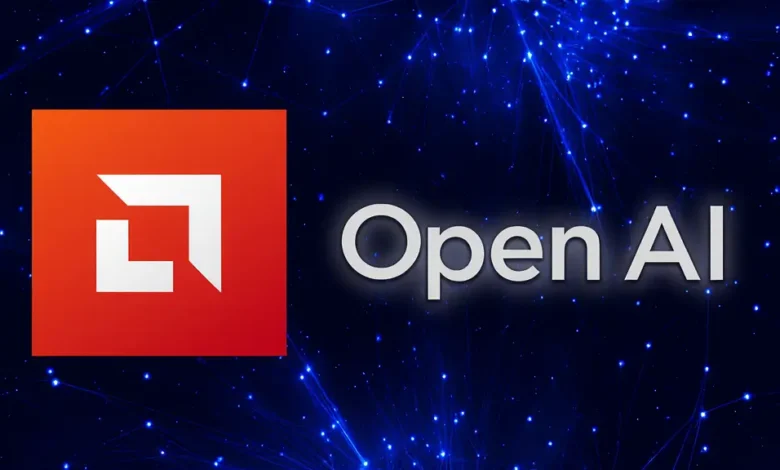AMD Stock: How the OpenAI Deal Redefined AMD’s Position in the Global AI Race

AMD stock surges as the OpenAI partnership reshapes its role in the artificial intelligence ecosystem, positioning the chipmaker as a formidable challenger to NVIDIA’s dominance.
table of contents
The Strategic Shockwave Behind AMD Stock’s Rise
When news broke that Advanced Micro Devices (AMD) had secured a multi-year AI chip supply deal with OpenAI, the markets erupted. Within hours, AMD stock experienced one of its most explosive rallies in years — soaring by over 35% in early trading.
But beyond the price surge lies a deeper story: a technological and strategic realignment that could redefine AMD’s trajectory in the artificial intelligence (AI) era.
This partnership is more than a transaction. It’s a statement of intent — that AMD is ready to move from being a follower in AI infrastructure to a core player shaping its global evolution.
AMD Share Price Surges After OpenAI Deal: How Technology is Rewriting the Chip War
How the AMD–OpenAI Partnership Could Reshape the Global AI Infrastructure Market
AMD Stock and the OpenAI Deal: A Turning Point
The OpenAI agreement gives AMD two critical advantages: validation and volume.
For years, AMD has been known primarily for its Ryzen CPUs and Radeon GPUs, fighting an uphill battle against NVIDIA’s market dominance in data centers. But now, AMD’s Instinct MI450 chips will power OpenAI’s next-generation compute clusters — potentially representing up to six gigawatts of AI capacity over the coming years.
As part of the agreement, OpenAI also received an option to acquire up to 10% of AMD’s stock through performance-based warrants. This move intertwines the destinies of both companies — and gives AMD an unprecedented entry point into the global AI ecosystem.
The symbolism is clear: OpenAI’s trust equals market validation. Investors see it as proof that AMD can compete head-to-head with NVIDIA in high-performance AI computing.
The Global Market Dimension
AMD’s stock rally was not limited to Wall Street. The ripple effects reached European, Asian, and Middle Eastern markets, where investors and AI infrastructure providers began re-evaluating their strategies.
- Europe is seeking more diversity in its AI chip supply chain — AMD’s partnership provides an alternative to NVIDIA’s tight supply.
- Asia, particularly in markets like South Korea and Taiwan, sees AMD’s design agility as an opportunity to expand local AI manufacturing.
- The Gulf region — where sovereign AI programs are booming — may view AMD as a viable technological partner for large-scale AI cloud initiatives.
This isn’t just an American stock story anymore; it’s a global technological reconfiguration.
AMD’s Repositioning: From Hardware Maker to AI Enabler
The OpenAI deal highlights AMD’s broader strategy to evolve beyond hardware.
AMD is building a full AI stack — from compute hardware to optimized software frameworks like ROCm — aiming to make AI deployment more flexible and cost-efficient.
In essence, AMD is trying to transform from being a “chipmaker” to an AI infrastructure enabler. The difference is monumental:
- A chipmaker sells components.
- An infrastructure enabler defines ecosystems.
If AMD succeeds, the market narrative around AMD stock will no longer hinge only on hardware specs — it will center on AI ecosystem influence and platform scalability.
Challenges That Could Test AMD Stock’s Momentum
Despite the optimism, execution risk remains AMD’s biggest enemy.
- Manufacturing and Supply Constraints – Meeting OpenAI’s ambitious volume demands could stretch AMD’s production capacity, especially given its reliance on TSMC foundries.
- Performance Parity with NVIDIA – While AMD’s MI450 is impressive on paper, it still needs to prove real-world efficiency and software integration at OpenAI’s scale.
- Dilution Risk – Should OpenAI exercise its share warrants, AMD may face temporary shareholder dilution.
- Competitive Retaliation – NVIDIA and other players (like Intel’s Gaudi lineup) will likely intensify price and innovation pressure.
Markets are optimistic — but not naïve. Execution will determine if this surge becomes a transformation or a bubble.
Analyst Sentiment: Bullish but Cautious
Following the announcement, several Wall Street analysts raised their price targets for AMD stock, citing the deal as “a defining moment in AMD’s AI roadmap.”
However, they also warn of over-exuberance in near-term valuations. The consensus narrative:
“AMD has the right partner and the right vision — now it must deliver at scale.”
Investors are watching how AMD integrates OpenAI workloads, refines chip performance, and captures new enterprise clients using similar architectures.
The Broader AI Industry Impact
AMD’s entry into OpenAI’s supply chain could democratize AI compute, which has been largely monopolized by NVIDIA.
This diversification:
- Reduces pressure on global chip shortages.
- Opens the door for smaller AI labs and cloud providers to access high-end compute at lower costs.
- Potentially accelerates innovation by expanding competition and availability.
In the long run, AMD’s success could redefine the economics of AI training, balancing power, efficiency, and accessibility across markets.
Conclusion: The Future of AMD Stock Lies Beyond Price
The OpenAI deal has catapulted AMD stock into a new league. But the real victory isn’t in the share price jump — it’s in how AMD has repositioned itself as a strategic pillar of the global AI revolution.
If AMD can deliver performance parity, maintain reliability, and scale its AI chip ecosystem, it will not only challenge NVIDIA but also reshape the infrastructure of modern artificial intelligence.
This partnership marks the start of a new phase in AMD’s identity — from challenger to architect of the AI future.
Frequently Asked Questions (FAQ)
Q1: Why did AMD stock surge recently?
Because AMD announced a multi-year partnership with OpenAI to supply AI chips, validating its position in the global AI market and driving massive investor optimism.
Q2: Will the OpenAI deal dilute AMD’s shares?
Yes, potentially. OpenAI has the option to acquire up to 10% of AMD stock based on performance milestones, which could lead to mild dilution.
Q3: How does AMD’s AI chip compare to NVIDIA’s?
AMD’s MI450 aims to rival NVIDIA’s H100 in performance and efficiency. However, real-world validation at scale is still ongoing.
Q4: Is AMD now considered an AI company?
Not fully — but it’s evolving fast. AMD is transitioning from being a CPU/GPU company to a comprehensive AI infrastructure provider.
Q5: What’s the long-term outlook for AMD stock?
If the OpenAI partnership proves successful and AMD meets its performance and delivery targets, analysts expect sustained growth and a re-rating of its AI market value.
اكتشاف المزيد من Feenanoor
اشترك للحصول على أحدث التدوينات المرسلة إلى بريدك الإلكتروني.









